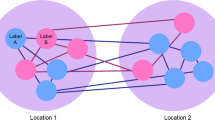Abstract
Andaya (2008) describes maritime Southeast Asia as a region evolving from a network of centers or mandalas. Such mandalas are often described as having “centers” with a gravitation of peripheral settlements and a confluence of the sacred and the “mundane.” This centric pattern stems from the conurbations of the micro with the macro, from the regional network to building spaces. Their core administrative and peripheral nodes are organized in a centric pattern, gravitating toward, and orbiting around, a central node. There were no distinctive physical boundaries between the center and the periphery; the “center” can be part of a network, which is then a part of a larger network with its own center. The centers of these networks and subnetworks are made distinctive and identifiable structures that complemented or were built upon natural formations within the local ecology and topography. The centrality of the center is marked by a dense and profiled combination of structure, architecture, and urban space. Many of these centers have disappeared due to the perishable nature of construction and the overlayering of development as a result of colonization.
Access this chapter
Tax calculation will be finalised at checkout
Purchases are for personal use only
Similar content being viewed by others
Notes
- 1.
The idea of liminality was introduced into the field of anthropology in 1909 by Arnold Van Gennep in his work Les Rites de Passage.
References
Andaya, B. W., & Andaya, L. Y. (2016). A history of Malaysia. Macmillan International Higher Education.
Andaya, L. Y. (2008). Malayu antecedents. In leaves of the same tree (pp. 18–48). University of Hawaii Press.
Ashadi. (2006). Warisan Walisongo. Lorong Semesta.
Evers, H.-D., & Korff, R. (2000). Southeast Asian Urbanism: The Meaning and Power of Social Space (L. V. Münster (ed.)).
Gordon, S. (2007). When Asia Was the World: Traveling Merchants, Scholars, Warriors, and Monks Who Created the “Riches of the East”. Da Capo Press.
Jahn Kassim, P. S. J., Kamaruddin, K., Ibrahim, I., & Harun, N. (2018). A tropicalized urban design framework from morphological patterns of pre-colonial maritime centers of the Malay world. Geopolotica Informatica, 1.
Janson, A., & Tigges, F. (2014). Fundamental Concepts of Architecture. In Fundamental Concepts of Architecture. Birkhäuser.
Kulke, H. (1993). “Kadātuan Śrīvijaya”-Empire or Kraton of Śrīvijaya? A Reassessment of the Epigraphical Evidence. Bulletin de l’Ecole française d’Extrême-Orient, 159–180.
Mabbett, I. W. (1977). The ‘Indianization’ of Southeast Asia: Reflections on the historical sources. Journal of Southeast Asian Studies., 8(2), 143–161.
Malawaraarachchi, R. H. (1999). Spatial progression in architecture: an examination of the concept of mainstream architecture. Master of Science dissertation, University of Moratuwa.
Meister, M. W. (1985). Symbol and surface: Masonic and Pillared Wall-structures in North India. Artibus Asiae, 46(1/2), 129–148. Published by: Artibus Asiae Publishers.
Munoz, P. M. (2006). Early kingdoms of the Indonesian archipelago and the Malay peninsula. Didier Millet, Csi.
Ooi, G. L. (1990). Town councils in Singapore: Self-determination for public housing estates (Occasional Paper No. 4). Singapore: Institute of Policy Studies.
Paul Wheatley. (1961). The golden Khersonese: Studies in the historical geography of the Malay Peninsula before A.D. 1500. (Malayan Historical Studies), p. 388, front. University of Malaya Press. (Distributed by Oxford University Press. 45s.).
Prasad, B. N. (2014). Cultic relationships between Buddhism and Brahmanism in the ‘last Stronghold’of Indian Buddhism. Buddhist Studies Review, 30(2), 181–199.
Rappenglück, M. A. (2012, June 11–14). The housing of the world: The significance of cosmographic concepts for habitation. Presented at Nexus 2012: Relationships between architecture and mathematics.
Roesmanto, T. (2002). A study of traditional house of northern Central Java-a case study of Demak and Jepara. Journal of Asian architecture and building engineering, 1(2), 219–226.
Sharif, H. M. (2014). Mosques in island Southeast Asia (15th-20th century). Journal of Architecture, Planning and Construction Management, 4(2).
Sherwin, M. D. (1981). The palace of Sultan Mansur Shah at Malacca. Journal of the Society of Architectural Historians, 40(2), 101–107.
Wolters, O. W. (2008). Early Southeast Asia: Selected Essays (No. 43). SEAP Publications.
Author information
Authors and Affiliations
Editor information
Editors and Affiliations
Rights and permissions
Copyright information
© 2023 The Author(s), under exclusive license to Springer Nature Singapore Pte Ltd.
About this chapter
Cite this chapter
Jahn Kassim, S., Ibrahim, M. (2023). From Archipelago to Architecture: The Sacred Center and the Pillared Space. In: Jahn Kassim, S., Abdul Majid, N.H., Razak, D.A. (eds) Eco-Urbanism and the South East Asian City. Palgrave Macmillan, Singapore. https://doi.org/10.1007/978-981-19-1637-3_8
Download citation
DOI: https://doi.org/10.1007/978-981-19-1637-3_8
Published:
Publisher Name: Palgrave Macmillan, Singapore
Print ISBN: 978-981-19-1636-6
Online ISBN: 978-981-19-1637-3
eBook Packages: Social SciencesSocial Sciences (R0)




